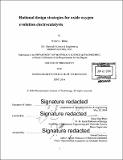Rational design strategies for oxide oxygen evolution electrocatalysts
Author(s)
Hong, Wesley T. (Wesley Terrence)
DownloadFull printable version (21.24Mb)
Other Contributors
Massachusetts Institute of Technology. Department of Materials Science and Engineering.
Advisor
Yang Shao-Horn.
Terms of use
Metadata
Show full item recordAbstract
Understanding and mastering the kinetics of oxygen electrocatalysis is instrumental to enabling solar fuels, fuel cells, electrolyzers, and metal-air batteries. Non-precious transition metal oxides show promise as cost-effective materials in such devices. Leveraging the wealth of solid-state physics understanding developed for this class of materials in the past few decades, new theories and strategies can be explored for designing optimal catalysts. This work presents a framework for the rational design of transition-metal perovskite oxide catalysts that can accelerate the development of highly active catalysts for more efficient energy storage and conversion systems. We describe a method for the synthesis of X-ray emission, absorption, and photoelectron spectroscopy data to experimentally determine the electronic structure of oxides on an absolute energy scale, as well as extract key electronic parameters associated with the material. Using this approach, we show that the charge-transfer energy - a parameter that captures the energy configuration of oxygen and transition-metal valence electrons - is a central descriptor capable of modifying both the oxygen evolution kinetics and mechanism. Its role in determining the absolute band energies of a catalyst can rationalize the differences in the electron-transfer and proton-transfer kinetics across oxide chemistries. Furthermore, we corroborate that the charge-transfer energy is one of the most influential parameters on the oxygen evolution reaction through a statistical analysis of a multitude of structure-activity relationships. The quantitative models generated by this analysis can then be used to rapidly screen oxide materials across a wide chemical space for highthroughput materials discovery.
Description
Thesis: Ph. D., Massachusetts Institute of Technology, Department of Materials Science and Engineering, 2016. Cataloged from PDF version of thesis. Includes bibliographical references (pages 143-160).
Date issued
2016Department
Massachusetts Institute of Technology. Department of Materials Science and EngineeringPublisher
Massachusetts Institute of Technology
Keywords
Materials Science and Engineering.